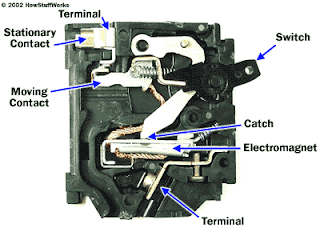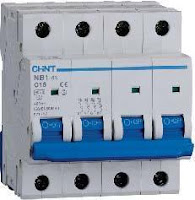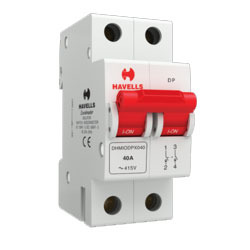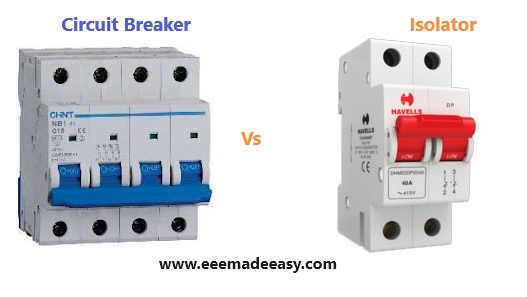Isolator Vs Circuit breaker: Lets learn the difference between isolation switch as compared to a circuit breaker.
Difference between Isolator and Circuit breaker
An isolating switch is a switching device that may not be able to break a normal load current or a short circuit current.
Usually an isolation switch is used on the supply side of a circuit breaker to provide visual proof that the circuit is broken and there is no possibility of power flowing through.
A circuit breaker is a switching device that not only can interrupt normal current flowing through an electrical load, but can also protect the circuit by interrupting a fault current created by a short circuit.
Download & Install EEE Made Easy App
Circuit breaker with parts

Circuit breaker

Isolator switch
Rotory isolator switch

In household power and other lower power circuit breakers, there are sensing mechanisms within the circuit breakers to sense electrical currents above expected levels.
This internal sensing mechanism will “trip” the circuit breaker, interrupting the current and therefore protecting the circuit much like a fuse will do.
The circuit breaker can be reset and energise the circuit again after the short circuit or fault is removed.
However, it should be noted that most circuit breaker manufacturers only test their molded case circuit breaker (the ones you use in your house) once for their short circuit rating. This means theoretically that the circuit breaker may not be able to interrupt another short circuit if it had to interrupt one that is close to its maximum rating.
In higher voltages, safety concerns dictate that an isolator switch be used on the supply side of a circuit breaker so that workers can see and lock the isolator switch in the open position after using the circuit breaker to de-energise the circuit.
Read More on Circuit Breakers
- Relay and Circuit Breakers MCQ Questions|EEE Made Easy
- How to open a circuit breaker
- Types of circuit breaker| Circuit Breaker Types
Latest Posts
Latest Posts in EEE Made Easy
- Environment MCQ for RRB JE CBT 2|Objective Questions Environment for Competitive Exams
- RRB JE CBT 2 Computer Awareness Book Arihant|Objective Computer Awareness Book 2025
- RRB JE CBT 2 Exam Date 2025 Postponed|RRB JE CBT 2 Exam Date
- [PDF]RRB JE Result 03/2024 Cut off, Selected no of candidates for all regions
- [PDF]Final Answer Key Junior Instructor Mechanic Agricultural Machinery|643/2023 Solved Question paper
- Acoustics MCQs|Industries Extension officer|IEO 2025
- LASER MCQs| Industries Extension officer|IEO 2025




